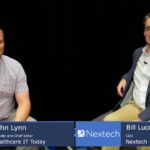One of the biggest decisions a triathlete makes is what type of gear to use. From bikes to shoes to padding, friction matters. And for athletes who want to perform well or even maximize their potential, fitness tracking matters. That’s why they spend hours deciding which smartwatch–and which features–to embrace. But even hard-core athletes can find surprises in their smart technology.
When Rosalind Picard, co-founder and chief scientist for the digital health dynamo Empatica, emailed me with her company’s latest news, I wanted a watch. The marketplace for health tech wearables has been slow to find universal adoption, and current players don’t have the technology chops to “win the market.” Scientists like Picard have the hardware technology expertise to take over the market that has progressed in fits and starts.
Healthcare technology seems enthusiastic about potential tracking partnerships with wearables and technology. Some of the devices are not medical grade. So the partnerships are exciting, until the quality of the technology matters. Similar to an athlete, when friction matters, we need better hardware to drive better health.
Empatica recently announced EmbracePlus, built in a partnership with the Translational Research Institute for Space Health (TRISH). These devices were designed to track the health of astronauts in space, an environment that hugely impacts individual health. Consistent monitoring is part of every space program. But in a market crowded with ineffective solutions, Empatica’s newest wearable also has a few features that can lead to significant breakthroughs for healthcare. One is a system that prompts reminders and ask questions. Another is tracking technology specialized for measuring autonomic stress. Discrete data about our health paired with artificial intelligence will provide more insights into how to change our behaviors for the better.
PERSONALIZED WEARABLES
When an athlete tracks their workouts with a heart rate monitor and a high-quality watch, they can see fitness trends over time. They can learn how much effort they need to put into running a mile at a certain pace, by measuring their heart rate. It is important to pick a watch that is waterproof and can measure distance in open water as well as the indoor pool.
The interesting thing about some of these trackers is that they can predict whether you are going to be sick. A friend of mine from an online triathlete group, Kate, talked about the importance of having a coach to interpret the data from a high quality wearable that she was receiving over time. She had been working out regularly, but suddenly Kate’s coach called and said she was coming down with something, because effort levels from the past few workouts were higher than the coach expected. Kate skipped her workout, visited the doctor and learned she had bronchitis. Fitness tracking allowed her trainer to see illness. Similarly, artificial intelligence can be trained to look at large population health trends over time. A high-quality hardware foundation enables us to find patterns that might not seem obvious at a single health encounter and might be missed by a less personalized device.
Personalized fitness advice makes a difference. But I’ve frequently found myself underwhelmed with the quality of fitness trackers out there. The collective med tech universe loves money and marketing, so they throw a fit every time a tech giant announces it will consider taking some healthcare dollars. While there is merit in getting big tech more interested in updating healthcare, some of my experience makes me wish we could instead infuse high-quality technology with more money–or marry the two.
EmbracePlus is a device that was designed for tracking health in space. Empatica has had success in tracking seizures. Its tech can detect which user is wearing a device. They have FDA approval for tracking seizures and their algorithm for detecting health. For a seizure patient, precise technology matters. Our heartbeat is like a fingerprint–unique to us. An excellent wearable can recognize its owner. Long-term medical sensing and technology designed for space wear such as this device provide a future where a user cannot get an insurance discount for letting their child wear your Fitbit at soccer practice. This technology is used in research about psychiatry and neurological disorders.
When I met Rosalind Picard, I realized that there are scientists who are working on better hardware. The high-quality future that healthcare technology should fund is in science and technology that can improve our health, not just finding a business case that seems good enough. A greater understanding of neurological disorders is something high-quality wearables can help with. The world of good enough will not drive wearables improving and transforming healthcare until hardware has higher quality.
In the land of wearables, there are apps that literally send our sexual data to Facebook to fuel customized ads. And if Facebook didn’t use it for ads– the point is that our data is being given to people who may or may not optimize it for our well-being. Health tech’s difficulty in finding an interesting direct-to-consumer product is showing in our excitement with what consumer giants might have to sell us. They have not been able to create a product that is hardy enough for real life. We are not all athletes and we are not all astronauts, but we can have data about our health. Wearables can be a key to the future of improving disease and understanding what each person needs.














Hello Janae, Your views in the article are to the point. I am also Healthcare It follower and have one vision for personal health-care, I am also in process to make a device for Monitoring personal health as accurate as I can, and also thinking about various wearables. I liked what you wrote, Clear, Crisp, Lucid.
I am looking forward to start communicating more with you regarding the IT HealthCare Sector.